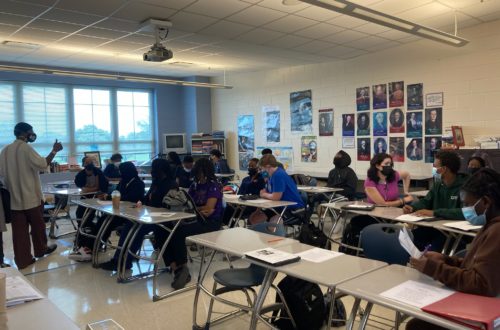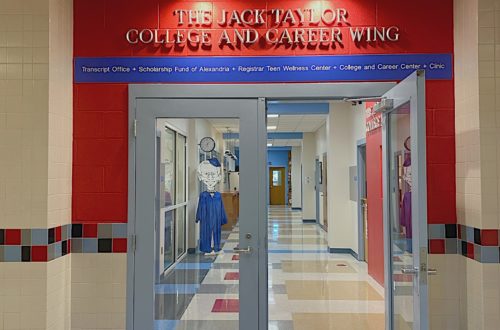The City Council and School Board will reconsider their permanent presence after the November election.
Yahney-Marie Sangaré
Staff writer
On October 12, the Alexandria City Council voted to temporarily reinstate the Student Resource Officer (SRO) program in Alexandria City Public Schools (ACPS) after it was dissolved by a 4-3 vote in May. On October 18, the two previous officers serving as SROs returned to campus. They will remain for the rest of the 2021-2022 school year.
The $789,909 initially reallocated from the SRO program was intended to fund additional mental health positions at Alexandria City High School; these positions were never filled.
The backlash following the removal of SROs coincided with an increase in violence since the beginning of the school year, including numerous publicized fights, an off-campus shooting involving ACPS students, and ACHS being placed on lockdown after a student brought a gun to campus. Although the rise in violence is not solely attributed to the removal of SROs (the role of handling school fights was always delegated to other positions), the timing of the SROs’ absence stressed pre-existing tensions surrounding student safety on school grounds.
“This was always an issue about school safety,” said ACHS Principal Peter Balas. “I see [SROs] as an essential resource.”
Police presence at school was originally brought into question due to potential connections between SROs and the school-to-prison pipeline, a phenomenon where juveniles are funneled into the criminal justice system from schools, often in the form of juvenile arrests during school hours.
Tenants and Workers United (TWU), a local activist coalition, fostered the student-led and largely testimony-based push to remove SROs. After a lack of support from School Board surrounding the dissolution of the memorandum of understanding between ACPS and the Alexandria Police Department (APD), various youth spokespeople approached the City Council with concerns about discrimination that may underlie the SRO program.
In a statement condemning the council’s reversal, TWU said. “Once again, Alexandria City finds itself on the wrong side of history.” It described other initiatives and programs that could have mitigated school violence in lieu of SROs, such as video security systems and community building.
Sophomore Yannet Gad, a class representative on the ACHS Black Student Union, shares concerns around the connections between schools and prisons. “The SRO program is a way for the school system to start the prison pipeline at a young age and it disrupts youth education. The $800,000 benefit that the SRO program receives should instead be used for mental health and other programs that actually help students be successful in their future.”
Critics of the initial decision maintain that there was not enough data to support a secure linkage between the school-to-prison pipeline and student resource officer presence in ACPS.
When criminal incidents occurred, outside APD officers were called in to handle the situation. SROs received specialized training in how to deal with adolescents and students. Regular officers do not undergo these measures. Balas said that “police presence increased after SRO removal.”
“We had officers who worked here (while SROs were gone) who said, ‘I’m never coming back.’ Meanwhile, you have two people who want to come back and work with teenagers,” said Balas. “Police presence increased after SRO removal.”
Of the voters in favor of returning SROs included Councilmember John Chapman, who had previously voted against their presence.
“My motion was not to keep SROs in schools. It was to keep them there for a certain amount of time, pull them out, and give ACPS the opportunity to form a new model,” said Chapman.
He expressed continued interest in their future replacement with mental health specialists, such as student safety coaches. “In order to bring those individuals in, we’d need some time, so delaying the removal (of SROs) or bringing them back was the proposed motion.”
Mayor Justin Wilson initially voted against the removal of SROs, citing concerns about the lack of data. “Any attempt to reconcile the sides will require grappling with (the issue of safety); figuring out at least some kind of collective understanding of safety. And that’s not easy….In this case, they directly conflict,” he said.
“The strongest polar views on this issue have been from people who have very little connection with our schools on both sides,” said Wilson. I do think you can bridge [different opinions]. You can’t bridge the extremes, but you can bridge the folks with more nuanced opinions.”
Chapman, still insistent on the eventual replacement of the SRO program, stated the need for an improved removal process moving forward. “Even those individuals (on the school board) who supported the removal of SROs still did not like ‘how we did it’,” Chapman said. “I think that the opportunity to talk more facts–local facts–with individuals around the benefits of having SROs outside of the schools and having other caring adults working with students and deescalating situations is something we can continue to talk about.”
“I think that (removing them again) would be a dire mistake,” said Balas. “I wish we could take it away from ‘stay’ or ‘remove’ and to ‘What do we want this to be?’ We have a chance to innovate here; it doesn’t have to be so extreme.”





